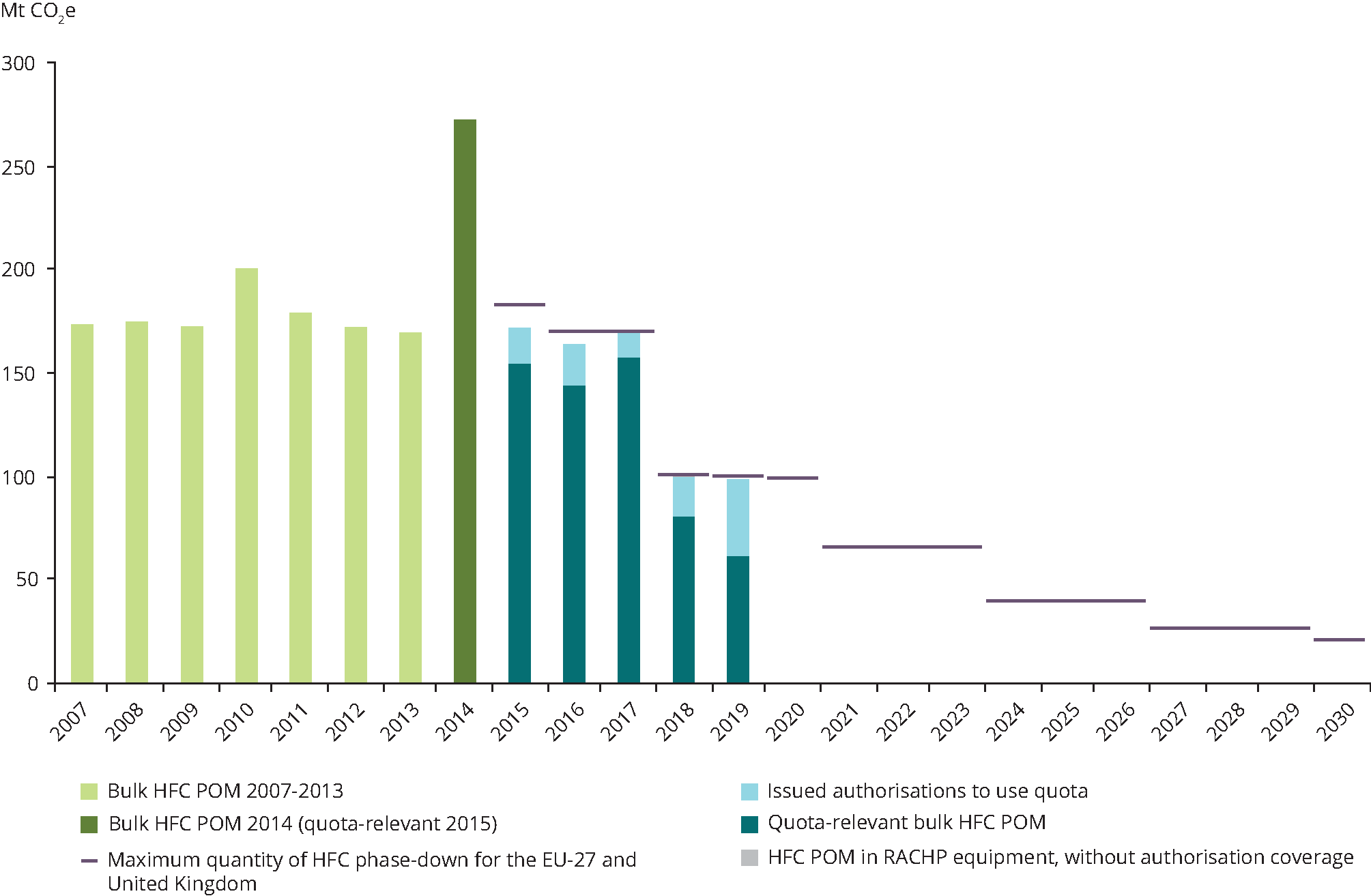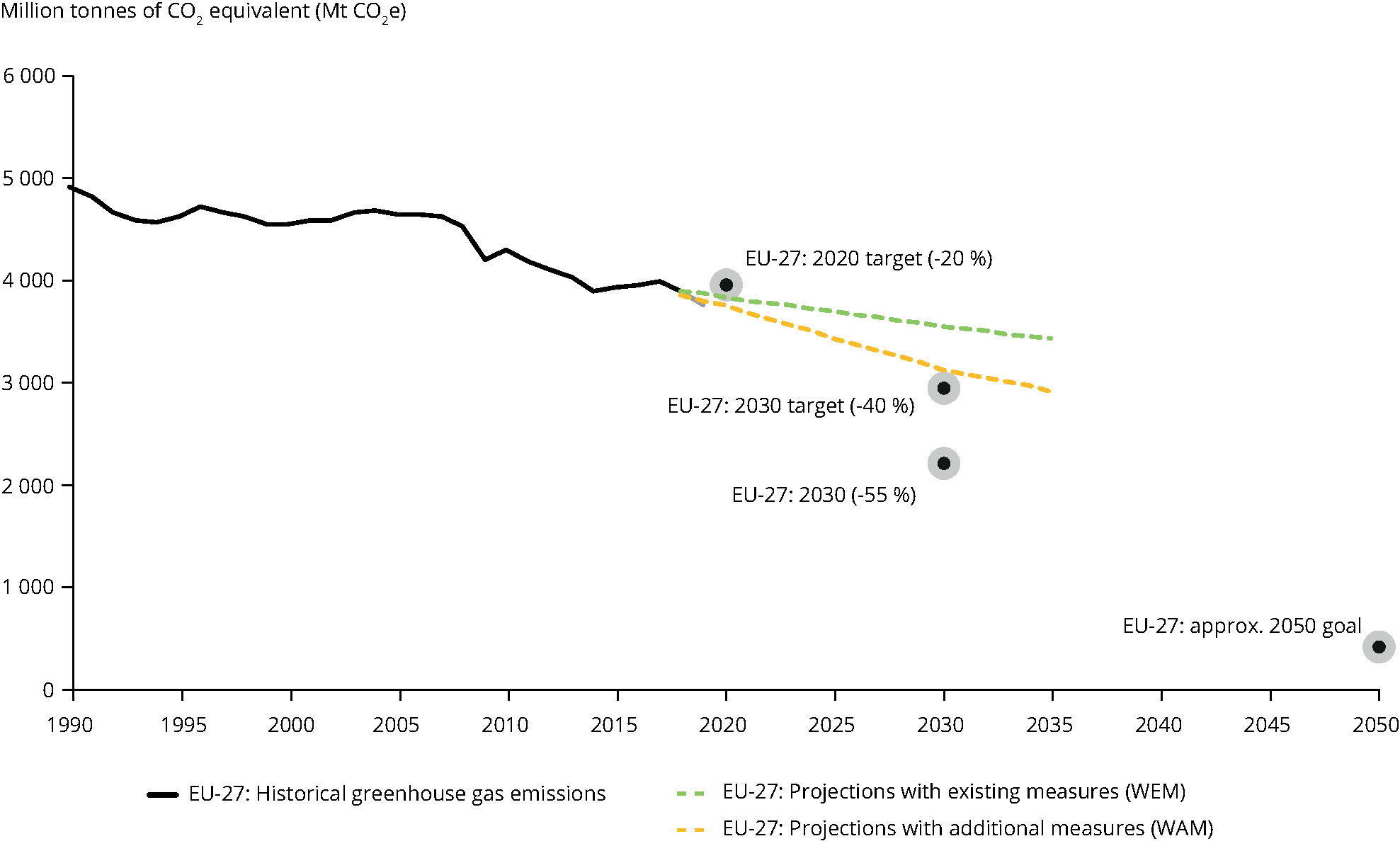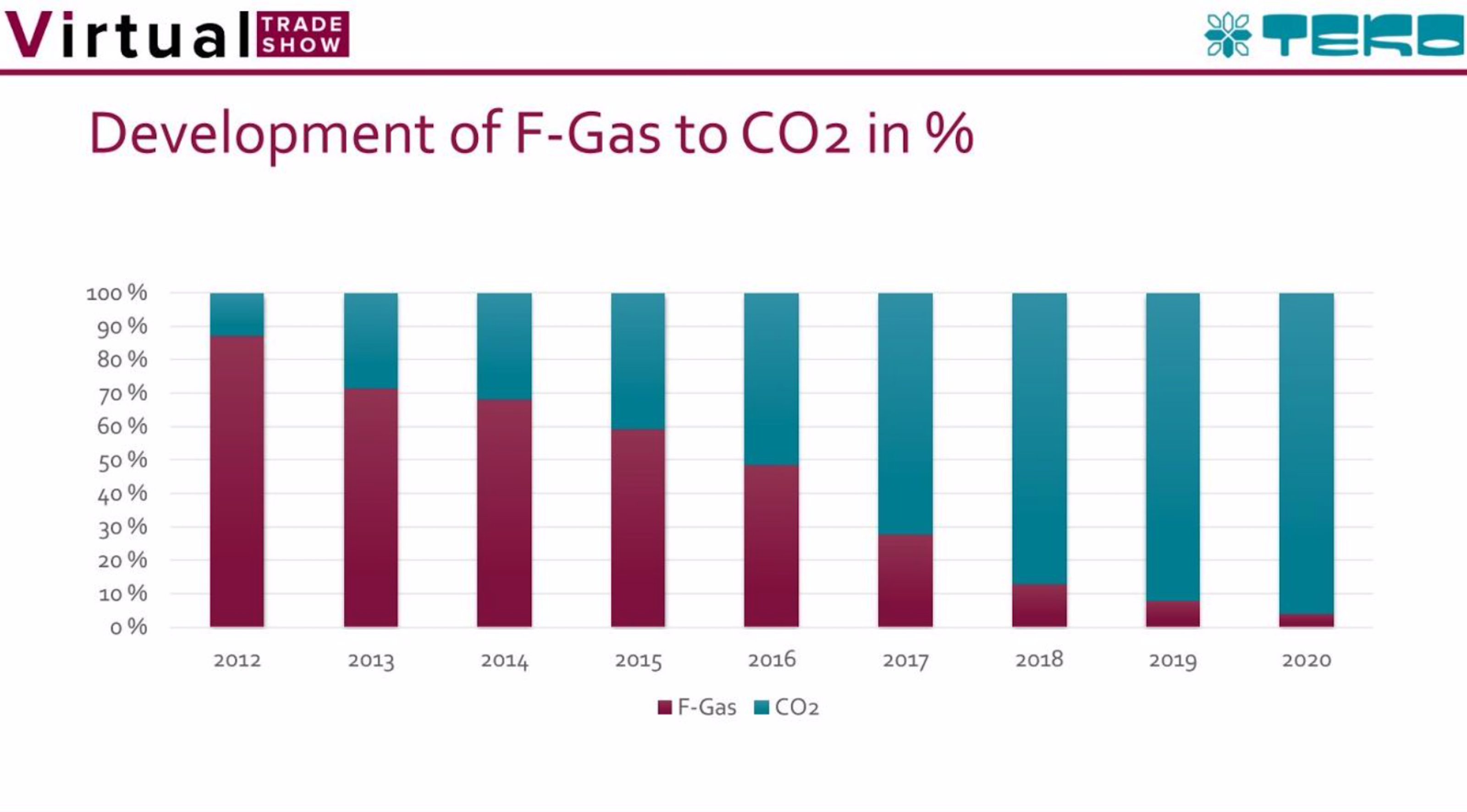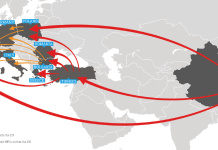The review of the F-gas Regulation is certainly the hottest theme for the cold sector in the current 2021 because this process might shuffle the cards on the table and propose more ambitious and stricter targets for the sector, compared to what provided by the current version of the Regulation (517/2014)
It aims at 79% reduction of HFC emissions (measured in equivalent CO2 tons) by 2030 versus the average of emissions in the 2009-2012 period. A possibility – that is to say, more ambitious incoming goals – absolutely not remote, due to the legislative changes and non- that have followed one another since 2014 – birth year of the current regulation – until today.
Let us briefly summarize:
- In 2014 the current F-gas Regulation was born;
- in 2016 is adopted the Amendment of Kigali to Montreal Protocol that provides for the reduction of the production and consumption of HFC by at least 80% in the next 30 years. It comes into force in 2019.
- In 2019 the Commission of Ursula von der Leyen presents the European Green Deal strategy that fixes for Europe the achievement of the carbon neutrality (net emissions equal to zero) by 2050.
To these events of political nature, we can add that in recent years we have witnessed a notable evolution of available technologies with low GWP or natural refrigerants, which has resulted in the availability and appreciation of technological solutions not fully consolidated in 2014, yet. In this context, we can hardly think that the F-gas Regulation can remain unchanged, also because in this case it would be neither compliant with the European Green Deal strategy by von der Leyen Commission. The European Commission, represented by Arno Kaschl, intervened in the second edition of VTS – Virtual Trade Show for natural refrigerants, organized by Shecco at the end of March, confirms that the revision is very likely to lead to more ambitious targets than current ones. Although it is premature to give concrete indications about the aspect of the future regulation, Kaschl states: «The F-gas Regulation is already now very ambitious: it aims at reducing by 2/3 the HFC on the market within 2030. We could be ambitious because the costs of this drastic reduction are affordable. However, at present we can see the results of a great evolution of technologies. Many changes occurred and this lets us glimpse much room to be more ambitious».

Towards what targets?
Too early, then, to say what image the new F-gas Regulation will have. While we are writing this text (April 2020) the Commission is analysing the responses obtained from the public consultation, remained open for any interested person until December 2020. If it is not possible to describe the face of the new regulation, yet, it is anyway possible to explain the general targets that will drive this review. They are listed by Barbara Gschrei, general director of Öko-Recherche, office entrusted by the Commission with the collection and analysis of data concerning the trend of the F-gas Regulation application.
The targets pursued by the Commission with this review are the following:
- Rising ambition in line with the European Green;
- Conforming to the goals of Montreal Protocol and Kigali Amendment;
- Increasing the structure and the affirmation of the Regulation coherently among member States, eliminating the possibility of wrong interpretations and favouring the clarification of still unsolved questions;
- Analysing all possible fields to improve the application of the Regulation
Building on these objectives, political proposals will be submitted consistently with the other European policies and they will be expected to bring added-value to Europe. Once defined the political proposals, they will be evaluated in terms of social, environmental and economic impact. They estimate the new version of the F-gas Regulation will be born in 2022.

Accelerating reduction times of HFC
The VTS session about the F-gas regulation was also attended by Tim Grabiel, lawyer specialized in environmental matters by the London NGO EIA, he presented the proposals of modification to the F-gas regulation by his Association, in some respects similar to those by other sector players, not only NGOs. Among modification proposals:
- Strengthening the measures to favour the conformity with the F-gas Regulation already in force:
- Limiting the illegal trade of refrigerants
- Modifying the distribution system of shares
- Establishing equal minimum penalties in all member States for the illegal traffic and promoting inspections at customs
- Making already existing obligations effective, such as, for instance, the destruction of noxious subproducts for the environment in the HFC production or the introduction of manufacturers’ environmental responsibility regime
- Promoting the adoption of HFC-free technologies and enhancing the ambition of the Regulation
- Speeding up the phase-down of HFC beyond Montreal protocol
- Removing the barriers for suitable climate solutions (standard, training, green public procurement)
- Introducing new prohibitions to the HFC use
Moreover, Tim Grabiel underlined the need of a quick action on fluorinated gases because the environmental warnings of the absolute need of stopping the temperature rise are already evident today, growing trend.
Method issues
In his speech, Tim Grabiel also mentioned a not secondary aspect for all policies that aim at limiting the climatic change, and objectively valid not only for HFC but for whatever new solution it is advisable to introduce: the need of considering the whole manufacturing process that leads to the solution at stake and the consideration of the environmental impact of each link of such process. It can in fact happen the final product conforms to defined environmental criteria but that during its production, owing to energy consumption reasons or to the formation of subproducts, it impacts on the environment in undesired manner. The example mentioned by Grabiel is the formation of highly noxious subproducts, such as HFC23, during the production of some HFC that, even if they comply with the low GWP requisites imposed by the Commission, imply the production and probably the release into the atmosphere of gases instead not conforming to environmental requisites. The speech by Grabiel stresses a fundamental methodological question: what is the point of having a “green” product if its production is “dirty”? Beyond the metaphor: is it meaningful to focus just on a link of the chain, when we know by now that the whole process must be considered because the entire process has an environmental impact? A theme that whatever appropriate legislative measure and whatever skilful technician cannot ignore.

GWP20? Highlights and drawbacks
The speech by Grabiel points out another aspect connected with method questions, that is to say the calculation of the GWP or global warming potential. It measures the power of a greenhouse-effect gas in a determinate lapse of time, compared to the carbon dioxide (CO2), reference molecule to which a GWP equal to 1 is attributed. That value is an absolute number, independent from the atmospheric concentration of the gas at stake. It just mirrors its properties of producing greenhouse effect and the higher it is, the “smarter” is the gas in causing the greenhouse effect. An important aspect of the GWP is the time scale used: there are GWP values that measure the greenhouse effect along 20 years of gas persistence in the atmosphere, along 100 and 500. This because there is a high variability in the atmospheric life of greenhouse gases. CO2, for instance, can have a persistence in the order of some centuries, CH4 (methane) 12 years, SF6 (sulphur hexafluoride) 3200 years, many HFC less than twenty years. Because of this variability, the GWP measurement on a time interval of 100 years has been considered the most appropriate compromise to compare the effect of the range of the various greenhouse-effect gases. The objection made to this compromise is that for short duration molecules, like HFC, it does not convey the right idea of the real environmental effect they cause. This idea was reaffirmed also by Tim Grabiel during VTS, indicating the GWP value of many refrigerants is higher if considered on an interval of 20 years, which also mirrors their average life in the atmosphere in more real way. Actually, as we can deduce also from an analysis carried out by Greenpeace and Ökorecherche in 2011, the GWP value of some refrigerants notably changes if we consider a time interval of 20 or of 100 years, indicating how, in the approximate twenty years during which they remain in atmosphere, these molecules cause a more serious damage than the one described by GWP100, as clearly indicated in table 1. Therefore, introducing an indication of the GWP20 value for molecules with average life close to this time interval would undoubtedly help in perceiving their effect on climate more realistically.
However, it is worth considering also another aspect that, instead, would disadvantage the climatic cause if we considered the GWP20, instead of the GWP100 of molecules. This point of view is supported by Climate Analytics, a multidisciplinary and culturally diversified team made up by experts in climatic sciences and environmental impacts, including IPCC authors, experts in climatic finance, adaptation, climatic negotiation, mitigation policies and analysis of climatic policies.
Climate Analytics starts from two fundamental preliminary assumptions:
- GWP100 is a compromise of the greenhouse effect measurement that considers in a single portfolio atmospheric long-life and shorter-life gases;
- GWP is a fundamental value on which are based climatic mitigation policies for the calculation of gas reductions in atmosphere.
According to Climate Analytics, with this GWP100 “compromise”, more weight is given to short-life gases in atmosphere versus gases with longer average life, such as CO2. Using a GWP20 that measures the warming effects on a 20-years period of time would exacerbate the compromise and would attribute even more weight to short-duration greenhouse gases, to the detriment of gases with longer persistence. This would be self-defeating for the fight to the climatic change: it would induce to overestimate the advantages of the reduction of certain gases, allowing for “distraction” or more “condescension” on long-term provisions for greenhouse gas decrease.
The question that arouses here spontaneously is a method question: it is sensible, to the ends of the implementation of the most possible efficacious measures, considering, in a single portfolio, gases with short average life and gases with secular life? Wouldn’t it be instead convenient to consider different reference systems? Perhaps, this proceeding would complicate calculations but the argument of the complexity increase is not valid when the goal is saving climate: climate is a complex matter and trivializing it on “simpler” calculations is not an option.
| Molecule | GWP20 | GWP100 | Average life in atmosphere (in years) |
| R32 | 2330 | 677 | 4.9 |
| R134a | 3838 | 1300 | 14 |
| R410a | 4340 | 2088 |
Table 1: Drawn from “The Benefits of Basing Policies on the 20 Year GWP of HFCs” written by Janos Maté (Greenpeace International) and David Kanter (Princeton University). Researches by Öko-Recherche GmbH in collaboration with HEAT GmbH (Germany). PDF available on https://ozone.unep.org
F-gas: an opportunity for the European industry
Representatives of the European refrigeration industry as well share Grabiel’s point of view about the need of reaching a more ambitious F-gas: this would be also a way for Europe to strengthen the pioneer role it has always played in the natural refrigeration sector. As affirms Andreas Meier – director of the German company TEKO, who took part in VTS – the vast majority of technologies and innovations in the natural refrigeration industry are “Made in Europe”, sector where Meier identifies great potentialities to create work in production but also in research and development. The case of TEKO is, in a certain sense, exemplary. Around 2010 TEKO, manufacturer of refrigeration components and systems, had in HFC its core business. Now, ten years later – a relatively short time interval –90-95% of TEKO business is focused on natural refrigerant systems. Besides, in the opinion of Andreas Meier, TEKO, it is not a single case. Meier believes the European industry has a great development potential in natural refrigeration; the F-gas Regulation has notably shared in triggering this potential and now the European industry needs clear undisputable signals, the way undertaken must be supported without hesitation also by regulations and it needs a roadmap that leads without hindrances to the successful establishment of these technologies in which Europe has been pioneer and is still leader today. Nowadays –Andreas Meier states – in some sectors there are no longer reasons for not choosing the natural refrigeration.




